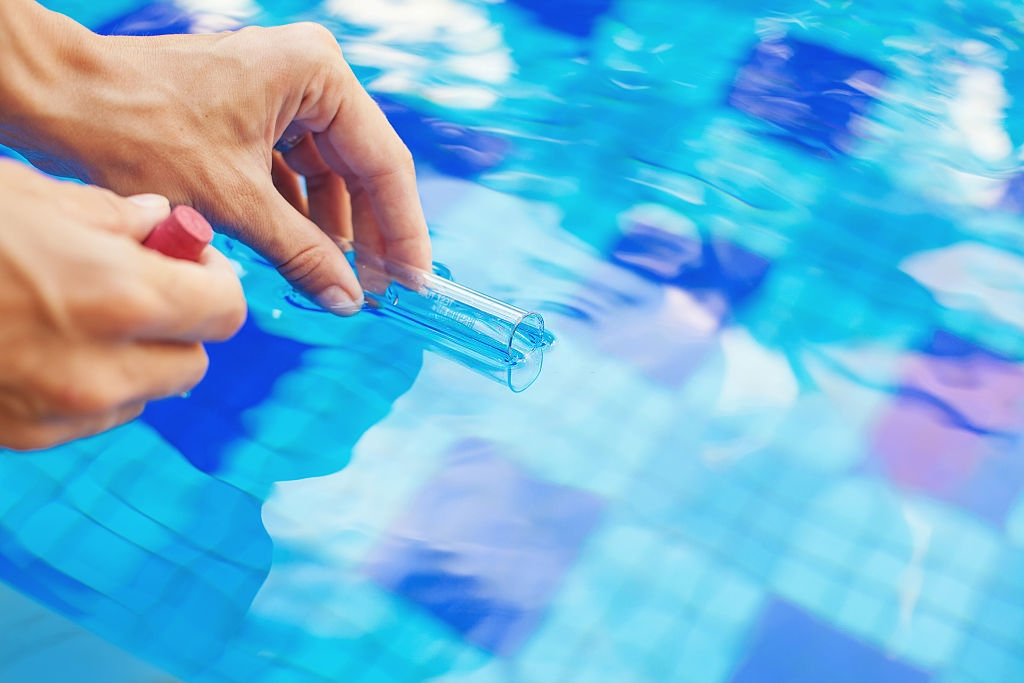
Maintaining proper swimming pool water chemistry is crucial for ensuring a safe, clean, and enjoyable swimming environment. Proper water balance not only keeps the water clear and free of harmful contaminants but also protects the pool’s structural integrity and equipment. Understanding the key components of pool water chemistry and how to manage them effectively can help you maintain a well-balanced and inviting pool. This comprehensive guide will cover the essential aspects of pool water chemistry, including pH levels, chlorine, total alkalinity, calcium hardness, cyanuric acid, and total dissolved solids.
1. pH Levels
The pH level measures the acidity or alkalinity of the pool water on a scale from 0 to 14, with 7 being neutral. For pool water, the ideal pH range is between 7.2 and 7.6. Maintaining the pH within this range is crucial because it affects the effectiveness of chlorine and the comfort of swimmers.
- Low pH (<7.2): Water becomes too acidic, which can cause skin and eye irritation, corrode pool equipment, and damage pool surfaces.
- High pH (>7.6): Water becomes too alkaline, leading to cloudy water, scaling on pool surfaces and equipment, and reduced chlorine effectiveness.
To adjust the pH level, use pH increasers (such as sodium carbonate) to raise the pH or pH decreasers (such as muriatic acid or sodium bisulfate) to lower it. Regular testing and adjustment are essential to keep the pH within the optimal range.
2. Chlorine
Chlorine is the primary disinfectant used in pools to kill bacteria, viruses, and algae. It helps keep the water safe and sanitary. Chlorine levels should be maintained between 1.0 and 3.0 parts per million (ppm) for optimal effectiveness.
- Free Chlorine: The amount of chlorine available to sanitize the water.
- Combined Chlorine: The amount of chlorine that has already reacted with contaminants.
- Total Chlorine: The sum of free and combined chlorine.
It is essential to regularly test and adjust chlorine levels, especially after heavy pool usage or rainfall, to ensure proper sanitation. Shock treatments (superchlorination) may be necessary to handle high levels of contaminants or eliminate combined chlorine.
3. Total Alkalinity
Total alkalinity (TA) measures the concentration of alkaline substances in the water, which helps buffer pH changes. The ideal TA range is between 80 and 120 ppm. Proper TA levels stabilize pH, making it easier to maintain.
- Low TA (<80 ppm): Can cause rapid pH fluctuations, making the water corrosive and potentially damaging to pool surfaces and equipment.
- High TA (>120 ppm): Can make it difficult to adjust pH and lead to scaling and cloudy water.
To adjust TA, use baking soda (sodium bicarbonate) to increase it or muriatic acid to decrease it. Maintaining the correct TA level helps keep the pH stable and the water balanced.
4. Calcium Hardness
Calcium hardness refers to the concentration of calcium ions in the pool water. The ideal range for calcium hardness is between 200 and 400 ppm. Proper calcium hardness levels are crucial for protecting the pool surfaces and equipment.
- Low Calcium Hardness (<200 ppm): Can cause the water to become corrosive, leading to etching of plaster surfaces and corrosion of metal components.
- High Calcium Hardness (>400 ppm): Can lead to scale formation on pool surfaces and equipment, cloudy water, and reduced circulation efficiency.
To increase calcium hardness, add calcium chloride to the water. If levels are too high, partially draining and refilling the pool with fresh water may be necessary to dilute the calcium concentration.
5. Cyanuric Acid
Cyanuric acid (CYA) is a stabilizer that protects chlorine from being degraded by the sun’s ultraviolet (UV) rays. The ideal CYA level for outdoor pools is between 30 and 50 ppm. Proper levels of CYA help maintain a consistent chlorine level, making the sanitizer more effective.
- Low CYA (<30 ppm): Chlorine dissipates quickly, reducing its effectiveness.
- High CYA (>50 ppm): Can reduce chlorine’s ability to disinfect and sanitize the pool water.
CYA levels can be increased by adding stabilizers containing cyanuric acid. If the CYA level is too high, the only effective solution is to partially drain and refill the pool with fresh water to lower the concentration.
6. Total Dissolved Solids
Total dissolved solids (TDS) measure the combined content of all inorganic and organic substances in the pool water, including minerals, salts, and organic matter. High TDS levels (above 1500 ppm) can lead to water balance issues, dull water, and reduced chlorine effectiveness.
To manage TDS levels, it is recommended to partially drain and refill the pool with fresh water periodically. This process helps maintain optimal water chemistry and prevents issues associated with high TDS.
7. Regular Testing and Maintenance
Regular testing of the pool water is crucial for maintaining proper chemistry. Use test strips, liquid test kits, or digital testers to monitor pH, chlorine, total alkalinity, calcium hardness, cyanuric acid, and TDS levels. Test the water at least once a week, and more frequently during periods of heavy pool use, extreme weather conditions, or when the pool is used by many swimmers.
In addition to regular testing, routine maintenance, such as cleaning the pool, skimming debris, brushing the walls, and vacuuming, is essential for maintaining water quality. Properly functioning pool equipment, such as filters and pumps, also plays a critical role in keeping the water clean and balanced.
Conclusion
Understanding and maintaining proper swimming pool water chemistry is essential for a safe, clean, and enjoyable swimming experience. By regularly monitoring and adjusting pH levels, chlorine, total alkalinity, calcium hardness, cyanuric acid, and total dissolved solids, you can keep your pool water balanced and inviting. A well-maintained pool not only enhances the swimming experience but also extends the life of the pool and its equipment. Proper water chemistry management is key to a healthy and sparkling pool, ensuring a safe and pleasant environment for all swimmers.


